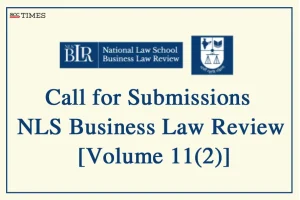The Editorial Board to the NLS Business Law Review is calling for submissions for Volume 11(2) of the Journal, which will be a special issue on Insolvency. NLSBLR is India’s premier student-run business and commercial law review. Over the past 8 years, we have had the pleasure and privilege of featuring articles written by leading luminaries in the legal field, such as Justice V. Ramasubramanian (Judge, Supreme Court of India), Mr. Philip R. Wood CBE, QC (Yorke Distinguished Fellow, University of Cambridge), Prof. (Dr.) Regis Bismuth (Professor, SciencesPo Law School), Mr. Rajat Sethi (Founder & Managing Partner, S&R Associates), and Prof. (Dr.) James J. Nedumpara (Head, Centre for Trade and Investment Law). The NLSBLR is also indexed in prominent databases like HeinOnline, SCC Online, and the Indian University Grants Commission’s Consortium for Academic Research and Ethics (UGC-CARE). This year, the theme for the special issue is: Eight Years and Counting: Is the IBC Turning Out to Be as Successful as Was Envisaged?
Scope and Rationale
The IBC was envisioned as a solution to India’s entrenched problems of non-performing assets and protracted insolvency resolution processes under the erstwhile legal frameworks. By adopting a creditor-centric approach and establishing a robust institutional framework through the National Company Law Tribunal (NCLT) and the Insolvency and Bankruptcy Board of India (IBBI), the Code was expected to ensure predictability, transparency, and economic revival. However, despite initial successes, the system has encountered significant hurdles, raising questions about its efficacy and fairness. This special issue seeks to provide a comprehensive evaluation of the IBC’s performance. The following are a set of illustrative sub-themes:
- Cross-Border Insolvency: The absence of a robust framework for cross-border insolvency remains a critical gap. In an increasingly globalized economy, the IBC’s lack of mechanisms to address insolvencies involving foreign creditors and assets has created legal ambiguities and hindered effective resolution. Without an established framework, Indian companies with foreign operations or creditors often face conflicting legal obligations and delayed processes. Moreover, the existing legal uncertainty discourages foreign investors from participating in Indian insolvency proceedings, adversely impacting asset recovery.
- Misuse of Powers by the Committee of Creditors (CoC): The CoC’s decision-making powers, especially in determining the viability and feasibility of resolution plans, have often been criticized for opacity and inequitable treatment of operational creditors. Financial creditors, who dominate the CoC, may prioritize their own recovery over the interests of operational creditors and other stakeholders, leading to skewed outcomes. Instances of alleged bias, such as rejecting viable resolution plans due to narrow financial interests or engaging in non-transparent negotiations, have brought the CoC’s conduct under scrutiny. The IBBI has also released a code of conduct for the CoC, aiming to ensure that the CoC does not act contrary to the objectives of the Code, laid down in the BLRC Report and espoused by various judgments of the Supreme Court such as Ebix Singapore v Committee of Creditors of Educomp.
- Implementation Challenges: Despite the Code’s emphasis on time-bound resolution, delays in the completion of Corporate Insolvency Resolution Processes (CIRP) and implementation of approved resolution plans have undermined its objectives. As is, recovery rates in the quarter ended September 2024 have fallen by 4 percent from 28.26% from 32.05% vis-à-vis the second quarter of 2024. Such delays often arise due to prolonged litigation, procedural inefficiencies, and lack of statutory clarity on timelines for implementing resolution plans. The Supreme Court’s observations in the Jet Airways case highlighted the nede for timely implementation to avoid erosion of asset value, highlighting the economic cost of delays. The liquidation of companies at a stage after approval only leads to further deterioration of the time-value of money, thereby questioning the efficacy of the entire CIRP process.
-
On the Distinction Between Financial and Operational Creditors: While the IBC has improved recovery rates, its impact on smaller creditors, employees, and other stakeholders remains contested. The disparity in the treatment of financial and operational creditors under the “waterfall mechanism” continues to attract criticism. The prioritization of secured financial creditors over employees and small operational creditors raises economic questions about the efficiency and inclusiveness of the insolvency process.
Submission Guidelines: The above themes are merely illustrative of some of the challenges associated with the Insolvency and Bankruptcy Code. Authors may choose to explore allied areas within the insolvency regime, including items on which the IBC is silent. The deadline for submissions is 11:59 p.m. on the 31st of March, 2025. Articles may be submitted in the form of the following categories:
- Long Form Articles (6,000 – 10,000 words): Submissions in this category are expected to engage with the topic, its theme, and available literature comprehensively so as to offer a novel and original reassessment.
- Essays (4,000 – 6,000 words): Submissions in this category are comparatively more concise and limited in their scope. Essays usually deal with a very specific topic as compared to Long Form Articles.
- Case/Legislative Comments (1,500 – 3,000 words): Submissions in this category are expected to critically analyse a recent judicial/quasi-judicial decision or legislative/policy proposal, either in India or abroad, and comment on its implications.
-
Book Reviews (2,000 – 3,000 words): Submissions in this category are expected to critically analyse and engage with a recent academic book that falls under our mandate.
The Submission Guidelines may also be found here. Please email us at nlsblrjournal@gmail.com for any queries.

